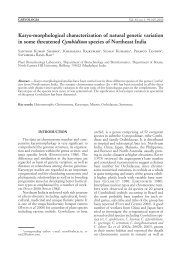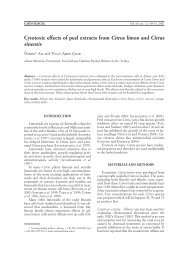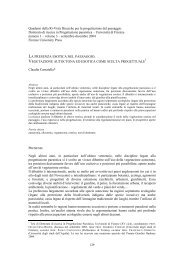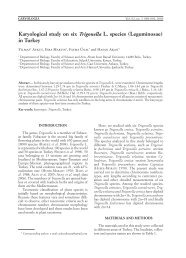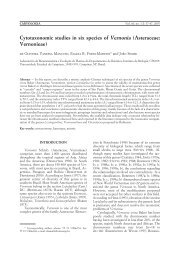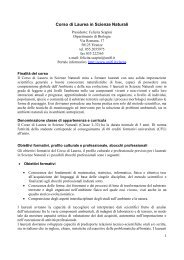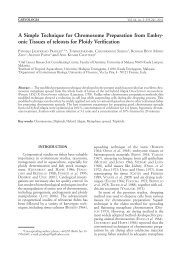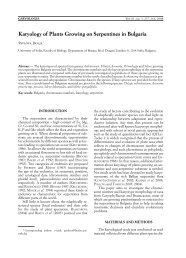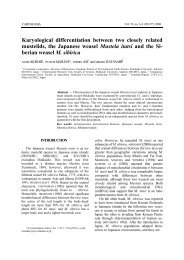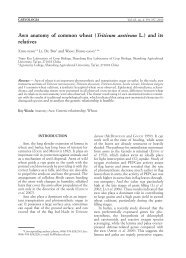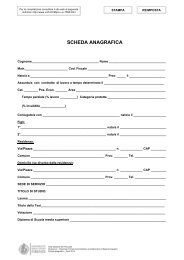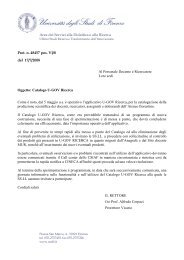A revised cytotaxonomy of the genus Tulbaghia (Alliaceae)
A revised cytotaxonomy of the genus Tulbaghia (Alliaceae)
A revised cytotaxonomy of the genus Tulbaghia (Alliaceae)
You also want an ePaper? Increase the reach of your titles
YUMPU automatically turns print PDFs into web optimized ePapers that Google loves.
88 VOSA<br />
SYNONYMS — <strong>Tulbaghia</strong> alliacea var. affinis Baker,<br />
sensu Link Enum. alt. 1: 310 (1821); Tul-baghia<br />
alliacea forma a Drege sensu Kunth Enum. 4: 483<br />
(1843); <strong>Tulbaghia</strong> ludwigiana Harv. forma macrior,<br />
sensu Kunth. Enum. 4: 483 (1843); <strong>Tulbaghia</strong><br />
campanulata N.E. Br. in Kew Bull. 175: 136 (1901);<br />
type: CAPE. - Queenstown Division: mts. near<br />
Queenstown, Galpin 1660 (K, holo!).<br />
ICONOGRAPHY — Batten & Bokelmann in "Wild<br />
Flowers <strong>of</strong> <strong>the</strong> Eastern Cape", p. 10, pi. 6, fig. 7<br />
(1996); Vosa, 1975, fig. 3, Plate I fig. 3; Vosa in J.S.<br />
Afr. Bot. 47: 57-61 (1981); Plate 1C.<br />
CHROMOSOME NUMBERS — 2n=2x=l2; 2n=4x=24<br />
(karyotype A, fig. 3).<br />
DISTRIBUTION — Eastern Cape to Nor<strong>the</strong>rn<br />
Transvaal. The diploids have been found so far only<br />
in <strong>the</strong> sou<strong>the</strong>rn part <strong>of</strong> <strong>the</strong> range.<br />
EXSICCATA — Diploids: NATAL. - 3030 (Port<br />
Shepstone): High Flats, Vosa 413/32 (OXF); CAPE. -<br />
3129 (Port St. John): 3.5 km S <strong>of</strong> Flagstaff, Vosa 14<br />
(OXF); - 3130 (Port Edward): between sand dunes,<br />
Vow 416/33 (OXF).<br />
Tetraploids: TRANSVAAL. - 3229 (Pieters-burg):<br />
Haenetsburg, near Old German Mission, Vosa 58<br />
(OXF). KWAZULU-NATAL. - 2931 (Stan-ger):<br />
Groenberg (Inanda), Vosa 406/31 (OXF); -2929<br />
(Underberg): Estcourt, Van der Merwe 2544 (PRE);<br />
CAPE. - 3326 (Grahamstown): Haye's Railway<br />
Sidings, Vosa 392/28 (OXF); 1.5 km NE <strong>of</strong> East<br />
London, on <strong>the</strong> side <strong>of</strong> <strong>the</strong> road to Gonubie Park,<br />
Vosa 306/16 (OXF).<br />
O<strong>the</strong>r exsiccata: CAPE. - 3227 (Stutterheim):<br />
King Williams Town, Dyer 254 (PRE); - 3425 (Port<br />
ELizabeth): near <strong>the</strong> town, Eayliss 1567 (K).<br />
VERNACULAR NAMES — Sou<strong>the</strong>rn Sotho: Moe-lela.<br />
Xhosa: Ivimba 'Mpunzi'. KwaZulu: Si'kwa.<br />
<strong>Tulbaghia</strong> cernua is a variable species and <strong>the</strong> two<br />
cytological forms overlap especially in <strong>the</strong> size <strong>of</strong> <strong>the</strong><br />
flowers and <strong>of</strong> <strong>the</strong> leaves. Its main characteristic is<br />
<strong>the</strong> urceolate or barrel-shaped fleshy corona, <strong>the</strong> lanceolate-obtuse<br />
perianth segments and <strong>the</strong> large rhizomatous<br />
base <strong>of</strong> <strong>the</strong> bulb. It can be distinguished<br />
easily from T. acutiloba (with which it shares <strong>the</strong><br />
character <strong>of</strong> <strong>the</strong> corona) by <strong>the</strong> very different leaves<br />
(very much narrower and tapering in T. acutiloba],<br />
by <strong>the</strong> larger corm and by <strong>the</strong> general shape <strong>of</strong> <strong>the</strong><br />
flowers which are smaller, narrower and elongated in T.<br />
acutiloba.<br />
T. cernua has been usually confused with T. alliacea<br />
and indeed many herbarium collections bear this<br />
name. However, it is very distinct and T. alliacea is<br />
found only in <strong>the</strong> winter rainfall region <strong>of</strong> <strong>the</strong> Cape<br />
Province. Besides distribution, <strong>the</strong> differences be-<br />
tween T. alliacea and T. cernua include important details<br />
<strong>of</strong> morphology and <strong>of</strong> karyotype. An illustration<br />
agreeing with T. cernua appears under <strong>the</strong> name <strong>of</strong> T.<br />
alliacea in: "Wild Flowers <strong>of</strong> <strong>the</strong> Eastern Cape Province"<br />
by Batten and Bokelmann, p. 10, PI. 67, fig. 7<br />
(1966). No indication is given about <strong>the</strong> location <strong>of</strong><br />
<strong>the</strong> original plant except that <strong>the</strong> species is known to<br />
occur throughout <strong>the</strong> Cape.<br />
Fig. 3 — <strong>Tulbaghia</strong> cernua (2x), karyotype A.<br />
4. <strong>Tulbaghia</strong> ludwigiana Harv. Bot. Mag. 64: t.<br />
3547 (1837); Dietr. Synops. 2: 1090 (1840); non<br />
Kunth Enum. 4: 482 (1843); Ave-Lallemant, Bull. Cl.<br />
Phys. Math. Acad. Petersb. 3: 203 (1844); Uph<strong>of</strong>,<br />
Herbertia, 10: 46 (1943); Schnizlein, Icon. gr. 1: t. 55<br />
(1949); Vosa, Ann. Bot. (Rome), 34: 75-77 (1975);<br />
Burbidge, Notes R. bot. Gds. Edinb. 36: 86-88<br />
(1978).<br />
TYPE — Harvey in Bot. Mag. 64: t. 3547 (1837):<br />
iconotype!<br />
The species has been described and illustrated<br />
from cultivated material collected by Mr. Zeir (Zeyhr?)<br />
from <strong>the</strong> border <strong>of</strong> "Kafferland" and not known to<br />
have been preserved as herbarium specimen. The<br />
beautiful illustration in Bot. Mag. 64 (1837) has been<br />
selected as iconotype.




